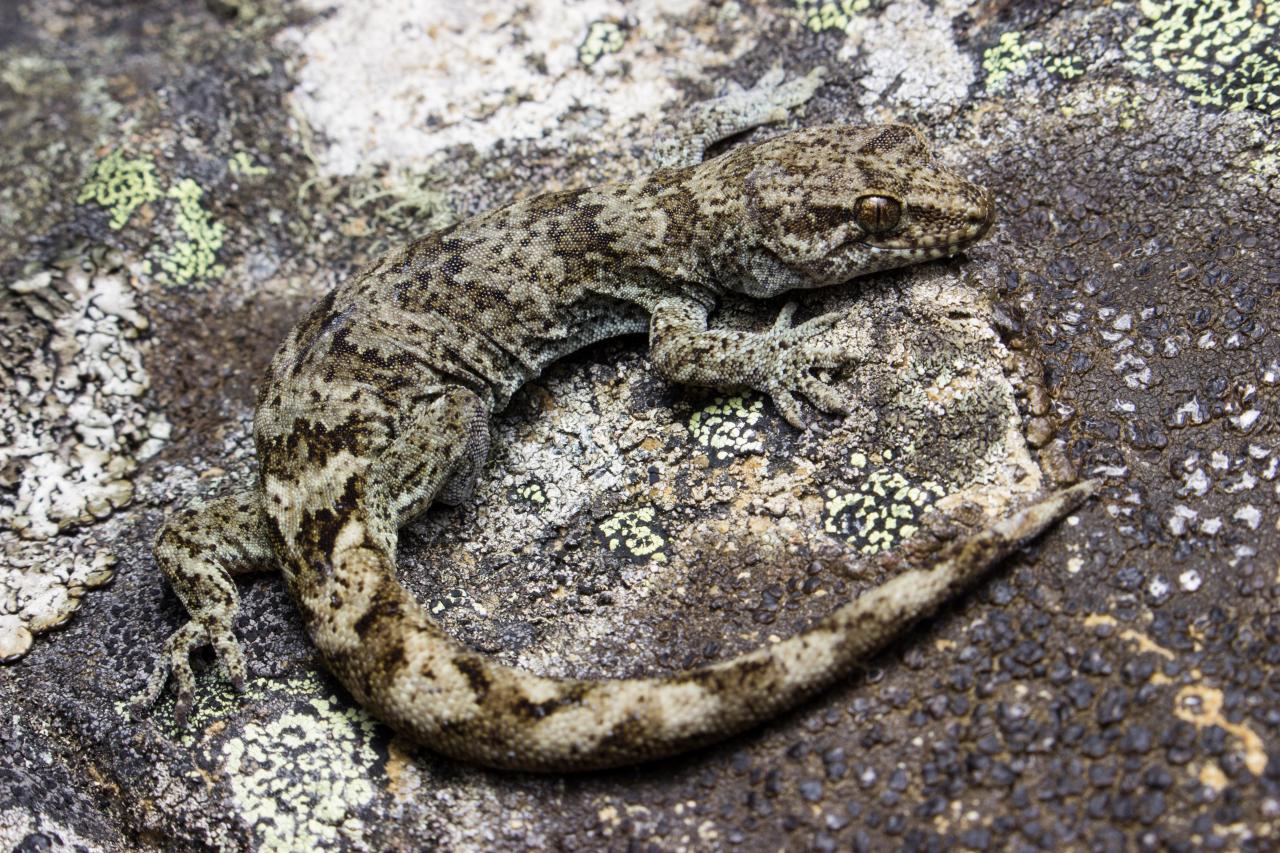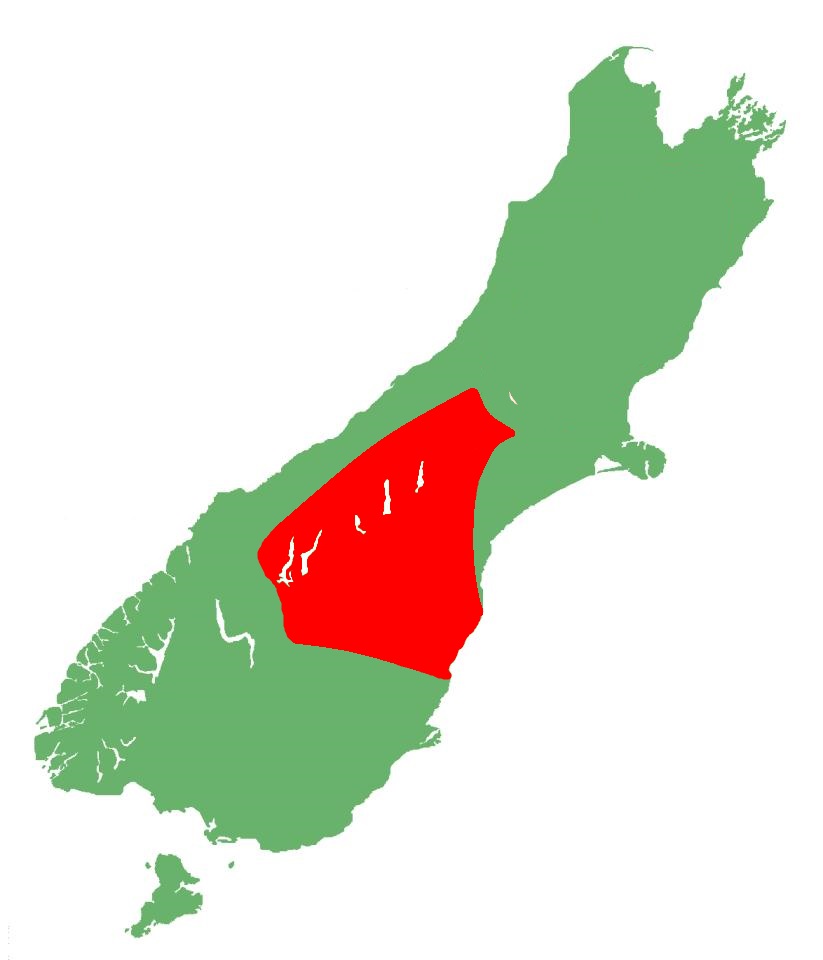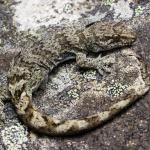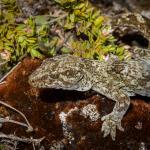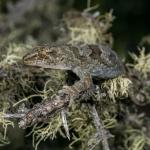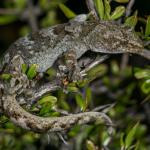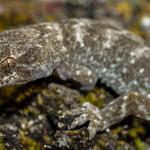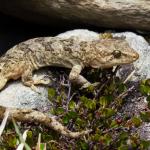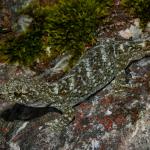- Home
- Herpetofauna Index
- Native
- Woodworthia "Southern Alps"
Woodworthia "Southern Alps"
Southern Alps gecko
Woodworthia "Southern Alps"
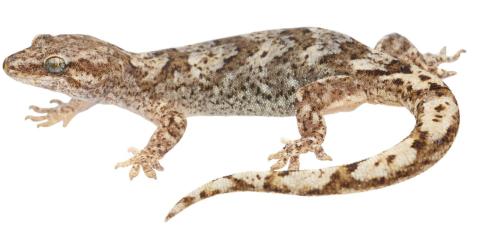
Length: SVL up to 72mm, with the tail being equal to or slightly longer than the body length
Weight: 5-10 grams
Description
A locally abundant, undescribed taxa from the "Southern Alps gecko" cryptic species complex. Southern Alps geckos are a medium-sized, robust, grey-brown variably marked gecko found throughout the central Eastern South Island high country, from the southern banks of the Rakaia River through to Otago. Most likely encountered basking or under rocks on stable scree slopes and outcrops in the sub-alpine, although known to occur arboreally in shrublands.
Southern Alps Gecko have a greyish top surface with alternating bands/blotches (striping rare). Sides are greyish with pale or darker coloured blotches, flecks or streaks. Belly surface light brown. Mouth lining and tongue pink, commonly with a grey tip on the tongue. Eye colour grey to green. Rostral scale in contact or virtually in contact with nostrils. Toes with tapering distal phalanges. Sub-digital lamellae 9–12.
Separated from the greywacke gecko by the Rakaia River, although vary slightly in morphology:
- The greywacke gecko is often larger, darker grey/brown in colour, and less stocky, with a longer neck, less finely divided markings and usually lacking the canthal stripe.
- The Southern Alps gecko varies in body size considerably between individual populations over quite short distances. Neck and snout stocky with a prominent canthal stripe. Silvery grey in colour.
Range abuts:
- Pygmy gecko (Woodworthia "pygmy") in the Rangitata Valley. Frequently found together under the same rock. Pygmy gecko much smaller, with narrower toes and fewer lamellae (7–9), and rostral scale well separated from nostrils.
- Waitaha gecko (Woodworthia cf. brunnea) at edges of the Canterbury Plains, but usually separated by altitude, and Waitaha gecko brown (vs. grey), with more contrasting markings, and brown to yellow (vs. green to grey) eye.
- Korero gecko (Woodworthia "Otago/Southland large") in the Waitaki Valley and at the northern end of the Dunstan Mountains, but Korero gecko bigger
- Kawarau gecko (Woodworthia "Cromwell") around Wanaka and at the northern end of the Dunstan Mountains, but Kawarau gecko species slenderer, with longer narrower toes and distinctly longer distal phalanges.
Life expectancy
Unknown, but likely to be similar to other Woodworthia e.g. up to 50+ years.
Distribution
Eastern South Island high country, from the southern bank of the Rakaia River through to northern Otago.
Ecology and habitat
Generally nocturnal but occasionally seen basking in daylight. Primarily terrestrial and saxicolous (rock-dwelling) although some populations are known to be arboreal. Southern Alps geckos live at lower elevations between mountain ranges, but also range up into the alpine (1800 metres a.s.l). Can be found in the stable bases of scree slopes, rocky river terraces and shattered outcrops in dry sub-alpine. Known to inhabit rocks like greywacke and schist. This species has been found to co-occur with the orange-spotted gecko (Mokopirirakau "Roys Peak").
Social structure
Found both solitary and communally, in population groups of up to a dozen or more.
Breeding biology
Twin viviparous offspring born late summer. Likely biennial in high-altitude populations.
Diet
As with other members of the Woodworthia genus, likely to feed on a combination of invertebrates, nectar and seasonal fruit. Potentially a key sub-alpine pollinator and seed spreader. May feed on smaller gecko species including cannibalism.
Disease
Orange mites are typically found on approximately a third of individuals. Ticks are rarely sighted.
Conservation strategy
This species is not being actively managed. Although historically considered to be "Not Threatened" (Hitchmough et al., 2016), its status was elevated to "At Risk: Declining" after the taxon was split into a northern (greywacke gecko) and southern clade (Southern Alps gecko) (Hitchmough et al., 2021).
Interesting notes
This small gecko gets both its common and TAG names from the large mountain range (known as the Southern Alps) that encompasses the vast majority of its distribution.
Southern Alps geckos are members of the 'common gecko' complex, a group of closely related species which are regionally distributed throughout New Zealand. Historically, most of these were considered a single highly-variable species - Hoplodactylus maculatus (the so called 'common gecko'). The 'common gecko' has now been separated into over ten different species.
The Southern Alps gecko, along with its sister taxa the greywacke gecko sit within the Southern clade of the Woodworthia complex, with the kōrero gecko (Woodworthia "Otago/Southland large") being their closest relative within the group.
References
Jewell, T. (2008). A photographic guide to reptiles and amphibians of New Zealand. Auckland: New Holland.
van Winkel D, Baling M, Hitchmough R (2019): Reptiles and Amphibians of New Zealand, A Field Guide. Auckland University Press, Auckland, New Zealand.

